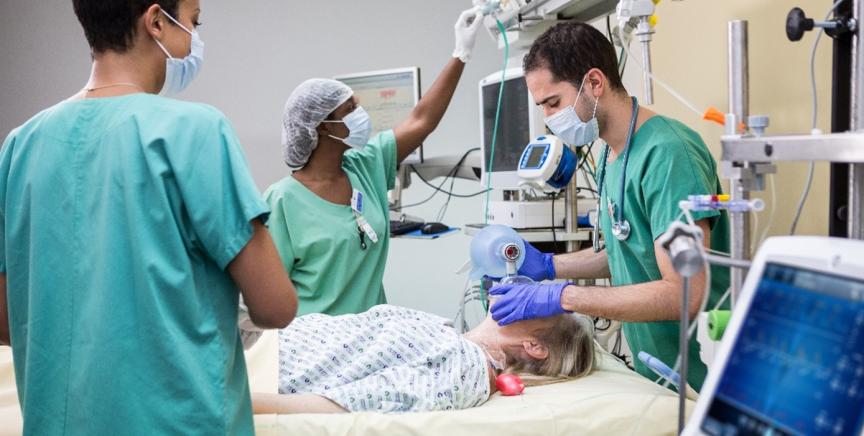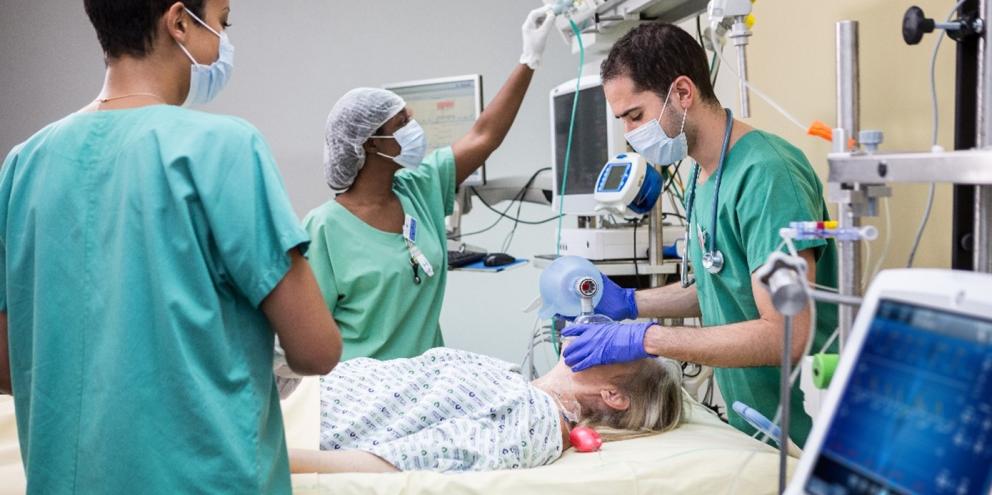
Postoperative pulmonary complications (PPCs) are a major cause of postoperative morbidity and mortality, particularly in the first postoperative week2 and are responsible for substantially increasing the length of patient hospital stays1. Yet, despite the fact that these complications represent a substantial portion of the risk associated with surgery, exactly which issues are included in the definition of PPCs, as well as their incidence, has been a subject of debate.
However, when you consider the fact that more than 234 million surgical procedures are performed each year throughout the world1 and that one systematic review of studies of non-cardiac surgery alone found that PPCs occur in 2 to 19% of cases1, it’s easy to see why even a small reduction in their incidence can have a significant impact on patient safety outcomes.
While a wide range of patient, anesthetic, and surgical factors are associated with PPCs4, patient monitoring, both during surgery and during the perioperative period, provides one of the clearest paths to helping to avoid or reduce these pulmonary issues and the damaging after-effects that can follow.
In this article, we’ll discuss four landmark studies which delve into the incidence of PPCs in varying types of surgeries. We’ll also look at which patients are at the highest risk for PPCs and the impact of these complications on morbidity, mortality and length of stay in order to illuminate the importance of patient monitoring for PPC reduction.
International Study Discovers 28% Overall Risk of PPC
The first study we’ll discuss is the ‘Local ASsessment of VEntilatory management during General Anaesthesia for Surgery’ (LAS VEGAS) study3. This multi-center prospective cross-sectional study was the first to determine the incidence of surgical patients at increased risk of PPCs using the ARISCAT score on an international basis.
PPCs were defined as any of a composite of conditions including:
- Unplanned supplementary oxygen
- Respiratory failure
- Unplanned new or prolonged invasive mechanical ventilation after discharge from the operating room
- Acute respiratory distress syndrome (ARDS)
- Pneumonia
- Pneumothorax
Researchers scored the number of PPCs developing in the first five postoperative days, length of hospital stay, and in-hospital mortality and the results clearly showed the danger represented by pulmonary complications during the post-surgical period.
Overall, after following 9,864 patients, the number at increased risk of PPCs was found to be 28.4%. The researchers also determined that patients at increased risk of PPCs had higher in-hospital mortality rates of 1.7% versus 0.2% for patients without risk for these complications.
PPCs: A Leading Cause of Poor Surgical Outcomes
A second study, by Fernandez-Bustamante et al. titled “Postoperative Pulmonary Complications, Early Mortality, and Hospital Stay Following Noncardiothoracic Surgery” calculated the rate of PPCs at seven U.S. academic institutions, finding that PPCs are a leading cause of poor surgical outcomes2.
The study included 1,202 patients with a mean age of 62.1 years who underwent predominantly abdominal, orthopedic, and neurological procedures. Of these patients, 33.4% suffered at least one PPC, the most common of which were the need for prolonged oxygen therapy and atelectasis.
Patients most likely to develop PPCs included older patients and those with conditions including hypertension, chronic obstructive pulmonary disease, and cancer.
However, the most significant finding of the study was the fact that patients with one or more PPCs, even mild, experienced:
- Significantly increased early postoperative mortality
- Higher incidence of intensive care unit (ICU) admission
- Increased ICU/hospital length of stay
The authors concluded that, mild, frequently-occurring PPCs, such as atelectasis and a prolonged need for oxygen therapy increased attention and intervention in order to improve perioperative outcomes.
PPCs Significantly Increase 30-Day Mortality
The third study which we will look at by Canet et al. followed 2,464 patients undergoing surgery in 59 hospitals in Spain1. Titled “Prediction of Postoperative Pulmonary Complications in a Population-based Surgical Cohort”, this study found that the main PPC outcomes included the development of at least one of the following:
- Respiratory infection
- Respiratory failure
- Bronchospasm
- Atelectasis
- Pleural effusion
- Pneumothorax
- Aspiration pneumonitis
While this study found a lower incidence of PPCs, just 252 events or 5% of the patient population, the impact of these complications on other factors related to patient safety and experience were significant.
The researchers determined that for patients with a PPC, 30-day mortality was significantly higher compared to those without a PPC (19.5% versus 0.5%). Additionally, the median postoperative length of stay in patients with at least one PPC was much longer at 12 days than in those without a PPC, who averaged just 3 days.
The study also demonstrated that risk of PPCs was higher in patients with respiratory disease and heart failure, as well as in individuals with a history of smoking.
The Effect of PPCs on In-Hospital Mortality
The final study we’ll look at was conducted by Mazo et al. to test the generalizability of the predictive score known as Assess Respiratory Risk in Surgical Patients4. The study, “Prospective External Validation of a Predictive Score for Postoperative Pulmonary Complications”, recruited 5,859 surgical patients in Catalonia and assessed factors including:
- Age
- Preoperative arterial oxygen saturation in air
- Acute respiratory infection during the previous month
- Preoperative anemia
- Upper abdominal or intra-thoracic surgery
- Surgical duration
- Emergency surgery
PPC occurrence was also recorded including the incidence of respiratory infection or failure, bronchospasm, atelectasis, pleural effusion, pneumothorax, or aspiration pneumonitis. Overall, the researchers found that PPCs occurred in 7.9% of patients, with the most frequent complication being respiratory failure.
They also discovered that for patients who suffered PPCs, 65% experienced more than one complication, while 35% of patients had three or more. On average, most patients suffered a complication between days 2 and 6 postoperatively.
Yet, perhaps most worrisome was the finding that for patients with at least one PPC, in-hospital mortality was significantly higher (8.3%) compared to patients with no PPC (0.2%).
Improving Patient Safety and Outcomes with PPC Prevention
All of these studies demonstrate the fact that the risk of PPCs is high – ranging from 5% to over 28% and are associated with increased in-hospital and 30-day mortality in addition to increased length of hospital stays.
A keystone in the prevention of these complications and early treatment to reduce morbidity is intensive monitoring both perioperatively and postoperatively. However, while monitoring during the surgical period is the norm, postoperatively, monitoring is all too often intermittent, providing only a snapshot of the patient’s condition.
Continuous monitoring instead provides constant input to inform timely and accurate clinical decisions to help avoid the damage of PPCs to patient health and safety. When comparing intermittent to continuous monitoring, it’s very like driving a car in the dark and only switching on your lights one time an hour versus having your lights shining all of the time so that you can see any dangers that lie ahead.
Summary
- Postoperative pulmonary complications (PPCs) are common, occurring in 5 to 28% of patients1,3.
- PPCs dramatically increase morbidity, mortality and length of stay.
- Monitoring perioperatively and postoperatively can help prevent or reduce PPCs.
- Continuous monitoring gives clinicians real-time data on patient condition to help them improve safety and avoid the dangerous sequel of PPCs.
References:
1: Canet, Jaume et al. “Prediction of postoperative pulmonary complications in a population-based surgical cohort.” Anesthesiology vol. 113,6 (2010): 1338-50. doi:10.1097/ALN.0b013e3181fc6e0a
2: Fernandez-Bustamante, Ana et al. “Postoperative Pulmonary Complications, Early Mortality, and Hospital Stay Following Noncardiothoracic Surgery: A Multicenter Study by the Perioperative Research Network Investigators.” JAMA surgery vol. 152,2 (2017): 157-166. doi:10.1001/jamasurg.2016.4065
3: LAS VEGAS investigators. “Epidemiology, practice of ventilation and outcome for patients at increased risk of postoperative pulmonary complications: LAS VEGAS - an observational study in 29 countries.” European journal of anaesthesiology vol. 34,8 (2017): 492-507. doi:10.1097/EJA.0000000000000646
4: Mazo, Valentín et al. “Prospective external validation of a predictive score for postoperative pulmonary complications.” Anesthesiology vol. 121,2 (2014): 219-31. doi:10.1097/ALN.0000000000000334







